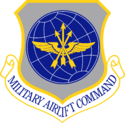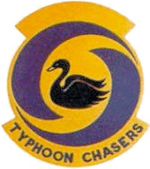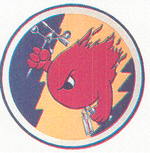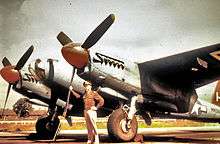54th Weather Reconnaissance Squadron
The 54th Weather Reconnaissance Squadron is an inactive United States Air Force unit. Its last assignment was to the 41st Rescue and Weather Reconnaissance Wing at Andersen Air Force Base, Guam, where it was inactivated on 30 September 1987.
54th Weather Reconnaissance Squadron
 | |
|---|---|
54th Weather Reconnaissance Squadron Lockheed WC-130 in flight | |
| Active | 1944–1947; 1951–1960; 1962–1987 |
| Country | |
| Branch | |
| Role | Weather Reconnaissance |
| Part of | Military Airlift Command |
| Nickname(s) | Fireball (1951-1960) Vulture (1962-1973) Typhoon Chasers (1973-1987)[1] |
| Engagements | European Theater of Operations Korean War[2] |
| Decorations | Air Force Outstanding Unit Award[1] |
| Insignia | |
| 54th Weather Reconnaissance Squadon emblem (approved 29 November 1973)[1] |  |
| 54th Weather Reconnaissance Squadron emblem (approved 9 July 1963)[1] |  |
| 54th Strategic Reconnaissance Squadron emblem (approved 10 August 1951)[2] |  |
| 654th Bombardment Squadron emblem (approved 23 October 1944)[1] | _-_Emblem.png) |
The squadron was first organized as the 654th Bombardment Squadron in August 1944. Flying de Havilland Mosquitos, the squadron provided weather and photographic reconnaissance and radar countermeasure support for VIII Bomber Command until V-E Day. It returned to the United States and equipped with Boeing B-29 Superfortress aircraft equipped for reconnaissance missions. Redesignated the 54th Reconnaissance Squadron it deployed to the Pacific, but arrived after hostilities had ended. It served until inactivating in 1947.
Redesignated the 54th Strategic Reconnaissance Squadron, the squadron resumed weather reconnaissance flights from Anderson Air Force Base, Guam, including some supporting forces in the Korean War. It was redesignated the 54th Weather Reconnaissancee Squadron in 1956 before inactivating in 1960. The squadron was reactivated in 1962 and continued the Pacific weather reconnaissance mission until 1987.
History
World War II
Background

Weather reconnaissance for VIII Bomber Command prior to March 1944 was provided on an ad hoc basis. The 18th Weather Squadron, which provided the command with weather observation and forecasting services through detachments located on each of the command's bases, detailed observers who flew on aircraft of various heavy bomber groups of the command. Rather than continuing to rely on individual bombardment units to perform this mission, on 22 March 1944, Eighth Air Force formed the 8th Reconnaissance Group (Provisional) at RAF Cheddington. On 30 March, the unit was redesignated the 802d Reconnaissance Group, Special (Provisional) and in April, the group moved to RAF Watton. The group's operational element was the 8th Reconnaissance Squadron (Provisional), which had been organized on 23 March 1944.[3]
Operations
On 9 August 1944, the 802d Group was discontinued and its mission was transferred to the regular 25th Bombardment Group with three operational squadrons. The 654th was primarily equipped with de Havilland Mosquitos, whose pilots had mostly entered the 802d Group from the 50th Fighter Group, where they had gained experience on fast multi-engine planes with Lockheed P-38 Lightnings. The 654th mission focused on supplementing the long range aerial reconnaissance mission of the 7th Photographic Group on missions where its two crewmember Mosquitos could perform better than the single seat Lockheed F-5 Lightnings and Supermarine Spitfires of the 7th Group. The mission expanded to include chaff dispensing, night photographic missions, and scouting targets for last minute weather information shortly before bomber forces were to attack them. The speed of the Mosquito provided it a certain amount of protection from enemy fighters, but shortly after the squadron was activated, it began to receive opposition from Messerschmitt Me 262 Schwalbe jet fighters and its reconnaissance missions began to operate with friendly fighter cover. The squadron also operated a few medium bombers on these missions.[4] [5]
Following V-E Day, the 25th Group returned to the United States for inactivation. However, the squadron remained active and re-equipped with Boeing B-29 Superfortresses. In December, it deployed to North Field, Guam for long range weather reconnaissance[2][4] The unit flew weather reconnaissance missions for the Far East Air Forces during the early postwar years, inactivating in October 1947.
Korean War
It was reactivated in 1951 at Andersen Air Force Base, Guam. The squadron resumed its weather reconnaissance mission with WB-29s; upgrading to Boeing WB-50D Superfortresses in 1955. It often flew hazardous reconnaissance missions into tropical storms and typhoons to obtain accurate meteorological information. It was inactivated in 1960 due to budget reductions.
The squadron was reactivated in 1960 with a mixture of WB-50s, Boeing WB-47 Stratojets and Lockheed C-130 Hercules and resumed its typhoon hunting mission. The squadron was the last operator of the WB-50D Superfortress, retiring the last aircraft in 1965, when it operated C-130s.
Vietnam War
Perhaps its best accomplishment was during the Vietnam War when Operation Popeye (Project Popeye/Motorpool/Intermediary-Compatriot) was a US military cloud seeding operation (running from 20 March until 5 July 1972) to extend the monsoon season over Laos, specifically areas of the Ho Chi Minh Trail. Operating WC-130A aircraft flying out of Udorn Royal Thai Air Force Base, the operation seeded clouds with silver iodide, resulting in the targeted areas seeing an extension of the monsoon period an average of 30 to 45 days. As the continuous rainfall slowed down the truck traffic, it was considered relatively successful. The 54th Weather Reconnaissance Squadron carried out the operation to "make mud, not war."
Cold War
In 1974, a newly converted WC-130 (serial number 65-965) was sent to investigate Typhoon Bess. The crew departed Clark Air Base in the Philippines with the callsign Swan 38. Radio contact with the aircraft was lost on 12 October 1974, apparently as the aircraft was heading into the typhoon's eye to make a second position fix. There were no radio transmissions indicating an emergency on board, and search teams could not locate the aircraft or its crew. All six crew members were listed as killed in action.[6]
It was inactivated in 1987, along with its associated weather unit, Detachment 3, 1st Weather Wing. The aircraft were dispersed to the remaining weather reconnaissance squadrons, the 53d Weather Reconnaissance Squadron and the Air Force Reserve unit, the 815th Weather Reconnaissance Squadron, both at Keesler Air Force Base, Mississippi.
Lineage
- Constituted as the 654th Bombardment Squadron, Heavy (Reconnaissance, Special) on 17 July 1944
- Activated on 9 August 1944
- Redesignated 54th Reconnaissance Squadron, Long Range, Weather on 4 September 1945
- Redesignated 54th Reconnaissance Squadron, Very Long Range, Weather on 27 November 1945
- Inactivated on 15 October 1947
- Redesignated 54th Strategic Reconnaissance Squadron, Medium, Weather on 22 January 1951
- Activated on 21 February 1951
- Redesignated 54th Weather Reconnaissance Squadron on 15 February 1954
- Discontinued and inactivated on 18 March 1960
- Organized 18 April 1962[7]
- Inactivated on 30 September 1987[8]
Assignments
- 25th Bombardment Group, 9 August 1944
- Third Air Force, 8 September 1945
- 311th Reconnaissance Wing, 27 November 1945 (attached to the Twentieth Air Force), 8 December 1945 – 28 February 1946
- Military Air Transport Service, 13 March 1946
- Air Weather Service, 20 March 1946
- 43d Weather Wing, 1 August–15 October 1947
- 2143d Air Weather Wing, 21 February 1951
- 1st Weather Wing, 8 February 1954
- Department of the Air Force, 18 March 1960 (not organized)
- Military Air Transport Service, 8 February 1962
- 9th Weather Reconnaissance Group, 18 April 1962[7]
- 9th Weather Reconnaissance Wing, 1 July 1965
- 41st Rescue and Weather Reconnaissance Wing, 1 September 1975 – 30 September 1987[8]
Stations
- RAF Watton (AAF-376),[9] England, 9 August 1944
- Drew Field, Florida, August 1945
- North Field, Guam, 27 November 1945
- Buckley Field, Colorado, 20 March 1946
- Langley Field, Virginia, 2 June 1946
- Morrison Field, Florida, 21 Jul 1946-30 Jun 1947
- McClellan Field, California, 1 July 1947
- Fairfield-Suisun Army Air Base, California, 31 July 1947
- North Army Air Base, Guam, 2 August–15 October 1947
- Andersen Air Force Base, Guam, 21 February 1951 – 18 March 1960
- Andersen Air Force Base, Guam, 8 February 1962 – 30 September 1987[7][8]
Aircraft
- North American B-25 Mitchell, 1944
- De Havilland Mosquito PR Mk. XVI, 1944-1945
- Martin B-26 Marauder, 1944-1945
- Lockheed P-38 Lightning, 1944-1945
- Boeing B-29 Superfortress, 1946-1947; 1951-1956
- Boeing WB-29 Superfortress, 1946-1947; 1951-1956
- Douglas C-47 Skytrain, 1946-1947
- Douglas C-54 Skymaster, 1951-1960
- Boeing C-97 Stratofreighter, 1952-1953
- Boeing TB-50 Superfortress, 1955; 1955-1960
- Boeing WB-50 Superfortress, 1955; 1955-1960
- Boeing WB-47 Stratojet, 1962-1965
- Lockheed C-130 Hercules, 1962-1965
- Lockheed WC-130, 1965-1987
Awards and campaigns
| Award streamer | Award | Dates | Notes |
|---|---|---|---|
| Air Force Outstanding Unit Award | March 1956-October 1956 | 54th Weather Reconnaissance Squadron[2] | |
| Air Force Outstanding Unit Award | 1 July 1967-30 June 1968 | 54th Weather Reconnaissance Squadron[10] | |
| Air Force Outstanding Unit Award | 1 January 1971-31 December 1971 | 54th Weather Reconnaissance Squadron[11] | |
| Air Force Outstanding Unit Award | 1 January 1975-31 May 1976 | 54th Weather Reconnaissance Squadron[1] | |
| Air Force Outstanding Unit Award | 1 September 1975-1 May 1977 | 54th Weather Reconnaissance Squadron[1] | |
| Air Force Outstanding Unit Award | 16 July 1977-16 July 1979 | 54th Weather Reconnaissance Squadron[1] |
| Campaign Streamer | Campaign | Dates | Notes |
|---|---|---|---|
| Air Combat, EAME Theater | 9 August 1944–11 May 1945 | 654th Bombardment Squadron[2] | |
| Northern France | 9 August 1944–14 September 1944 | 654th Bombardment Squadron[2] | |
| Rhineland | 15 September 1944–21 March 1945 | 654th Bombardment Squadron[2] | |
| Ardennes-Alsace | 16 December 1944–25 January 1945 | 654th Bombardment Squadron[2] | |
| Central Europe | 9 August 1944–21 May 1945 | 654th Bombardment Squadron[2] | |
| Streamer without inscription | 27 November 1945-2 March 1946 | 54th Reconnaissance Squadron[2] | |
| Streamer without inscription | 21 February 1951–27 July 1953 | 54th Strategic Reconnaissance Squadron[2] |
References
- Notes
- Markus, et al., p. 143
- Maurer, Combat Squadrons, pp. 697-698
- Freeman, p. 240
- Maurer, Combat Units, p. 76-77
- Freeman, p. 200
- Robison, Tom. "Whiskey-Charlie!". Air Weather Reconnaissance Association. Retrieved 26 September 2008.
- Lineage, including assignments and stations through 1963, in Maurer, Combat Squadrons, pp. 697-698
- Lineage, including assignments and stations from 1963 through 1987, in Markus, et al., p. 143
- Station number in Anderson.
- AF Pamphlet 900-2, 15 June 1972, p. 206
- AF Pamphlet 900-2, 30 September 1976, p. 33
Bibliography
![]()
- Anderson, Capt. Barry (1985). Army Air Forces Stations: A Guide to the Stations Where U.S. Army Air Forces Personnel Served in the United Kingdom During World War II (PDF). Maxwell AFB, AL: Research Division, USAF Historical Research Center. Archived from the original (PDF) on 23 January 2016. Retrieved 7 July 2012.
- Freeman, Roger A. (1970). The Mighty Eighth: Units, Men and Machines (A History of the US 8th Army Air Force). London, England, UK: Macdonald and Company. ISBN 978-0-87938-638-2.
- Markus, Rita M.; Halbeisen, MSG Nicholas F.; Fuller, John F. (1987). Matthews, James K.; Gustin, Joylyn I. (eds.). Air Weather Service: Our Heritage 1937-1987 (PDF). Scott AFB, IL: Air Weather Service. OCLC 18406969. Retrieved 10 June 2017.
- Maurer, Maurer, ed. (1983) [1961]. Air Force Combat Units of World War II (PDF) (reprint ed.). Washington, DC: Office of Air Force History. ISBN 0-912799-02-1. LCCN 61060979. Retrieved 17 December 2016.
- Maurer, Maurer, ed. (1982) [1969]. Combat Squadrons of the Air Force, World War II (PDF) (reprint ed.). Washington, DC: Office of Air Force History. ISBN 0-405-12194-6. LCCN 70605402. OCLC 72556. Retrieved 17 December 2016.
- "AF Pamphlet 900-2, Unit Decorations, Awards and Campaign Participation Credits" (PDF). Washington, DC: Department of the Air Force Index. 15 June 1971. Retrieved 11 August 2016.
- "AF Pamphlet 900-2, Unit Decorations, Awards and Campaign Participation Credits, Vol II" (PDF). Washington, DC: Department of the Air Force. 30 September 1976. Retrieved 11 August 2016.
